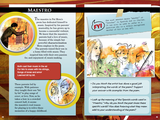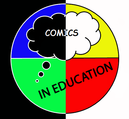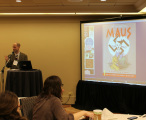FREQUENTLY ASKED QUESTIONS
Here are some common questions that come up about teaching comics and graphic novels in the classroom. If you have any others, please send them our way through the Contact tab and we'll add them to the list!
Question 1 -- Why would I use comics and graphic novels in the K-12 classroom?
There are a variety of reasons for using comics and graphic novels. I talk about these issues at length in a pair of opinion pieces I wrote for the Sequart Research and Literacy Organization: Everything I Know I Learned from Comics and Comics in the Classroom. Comics and graphic novels are ideal for reluctant and struggling readers because marrying the verbal and the visual helps to engage them while building their vocabulary and comprehension. However, the genre is also a must for the academic classroom because visual narrative is a significantly underrated kind of text that has tremendous interdisciplinary applications.
Question 2 -- How do I know what comics or graphic novels to use?
I've been asked this question so much by educators that it motivated me to develop this website. The straightforward answer is that you have to do your research, but so much is being written now that the searching is becoming easier. Starting with comics and graphic novels designed specifically for the classroom by educational publishers like Oxford and Scholastic is a great idea, and using this site to get a sense of what's out there in the trade market that can be used in the classroom is the next step toward more fully integrating visual narrative into your curriculum.
Question 3 -- How do I talk to parents who complain that their kids should be reading the classics, not comics and graphic novels?
Kids should be reading the classics, but they should also be reading widely and broadly across a variety of genres. Doing anything less than this ignores important forms of writing that are essential to a 21st-century learner's growth and development. Parents are often not looking to cast aspersions, but simply to be reassured that the books their kids are reading will help them in some way.
Question 4 -- I didn't grow up reading comics or graphic novels, so I'm not sure I'd be comfortable teaching them. How do I learn more?
You're at a good starting point with this site. Explore it and then have a look at the wealth of information out there that this site links to. It's the product of dozens of hours of painstaking research, so feel confident that what you need to know is out there and that Comics in Education is helping you to find it.
Question 5 -- Is Comics in Education available for in-class service or professional development support?
Our mission is to advance the use of comics and graphic novels in the K-12 classroom, and Comics in Education is always available to work with teachers, students, parents, administrators and library professionals to that end. Please contact Comics in Education through the Contact tab above for rates and availability in your area.





